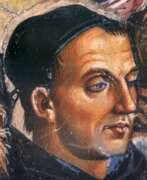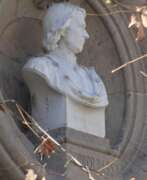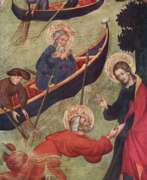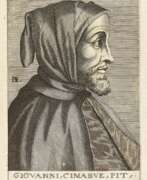Europe 14th century


Fra Angelico, a name synonymous with the serenity and purity of Early Renaissance art, was a Dominican friar and Italian painter celebrated for his devout and luminous religious works. Born Guido di Pietro around 1395 in Vicchio, near Florence, he later became known as Fra Giovanni upon joining the Dominican order at Fiesole. His monastic life profoundly influenced his art, reflecting a deep spiritual commitment and a heavenly tranquility. Pope John Paul II recognized his sanctity by beatifying him in 1982, officially bestowing upon him the title "Blessed" and affirming his legacy as a bridge between heaven and earth through his art.
Fra Angelico's technical prowess and innovative approaches to composition and color set new standards in the art world. He was initially trained as an illuminator, which is evident in the delicate details and luminous quality of his works. His art was not confined by his religious duties; instead, his position allowed him to advance the Dominican order's mission through visually compelling narratives that spoke directly to the viewer's soul. His works, including altarpieces and frescoes, are revered for their serene religious attitude and classical influence, embodying the Early Renaissance spirit that sought to harmonize Christian themes with the natural world and human emotion.
Among his most notable contributions are the frescoes at the convent of San Marco in Florence, commissioned by Cosimo de' Medici. These works display Angelico's mastery over perspective and his ability to create a spiritual atmosphere that invites contemplation. The Annunciation, one of his most famous frescoes at San Marco, exemplifies his use of architectural space to frame the sacred narrative, integrating the divine with the everyday. His altarpieces, characterized by their detailed figures and harmonious compositions, were innovative in their unified presentation of sacred stories, moving away from the segmented Gothic style towards a more cohesive and immersive narrative experience.
Fra Angelico's influence extended beyond his lifetime, shaping the trajectory of Renaissance art through his integration of humanistic principles with devout Christian faith. His works are preserved in some of the world's most prestigious museums, including the Museo Diocesano in Cortona, the Uffizi Gallery, and the Museo del Convento di San Marco in Florence, continuing to inspire awe and reverence among viewers.
For collectors and experts in art and antiques, the legacy of Fra Angelico offers a window into the soul of the Renaissance, where beauty and spirituality converge. To stay informed about new product sales and auction events related to this pivotal artist, signing up for updates is a prudent step towards enriching one's collection with works that embody the zenith of religious and artistic expression in the Early Renaissance.


Ferrer Bassa was a renowned Catalan Gothic painter and miniaturist, active in the early 14th century. His artistry not only graced the courts of Aragon but also laid the foundations of the Catalan School of painting. Bassa is celebrated for integrating the traditional Gothic style with French and Sienese influences, creating a unique visual lexicon that was ahead of his time.
Born around 1285, Bassa's career highlights include his work for Alfonso IV of Aragon and the impactful series of frescos in the St. Michael Chapel at the Monastery of Pedralbes in Barcelona. These frescos, executed between 1345-46, are Bassa's most significant surviving works. They showcase an Italianate style, featuring around twenty scenes that focus on the Passion of Christ and the Seven Pains of the Virgin. His work in the Great Canterbury Psalter also stands as a testament to his exemplary skills.
Bassa's contribution to the world of art extends beyond his own creations. He played a pivotal role in the evolution of the Catalan phase of Gothic painting, significantly influencing the period's artistic direction. His legacy was furthered by his son, Arnau Bassa, who continued his father's artistic journey.
For art collectors and enthusiasts, the works of Ferrer Bassa are more than historical artifacts; they are the keystones of Catalan Gothic art. His influence resonates in the works of subsequent artists and continues to inspire modern artistic expressions. For those wishing to delve deeper into the rich tapestry of Gothic art, Ferrer Bassa's works are an indispensable resource.
To stay informed about upcoming sales and auction events featuring Ferrer Bassa's works, we invite you to sign up for our updates. This subscription is tailored for enthusiasts and collectors like you, ensuring you never miss an opportunity to own a piece of this illustrious artist's legacy.


Lluís Borrassà, a prominent Catalan painter, is renowned for revolutionizing the Gothic painting style in Catalonia. Born around 1360 in Girona and possibly deceased in 1426 in Barcelona, Borrassà's contribution to the art world is immeasurable. He was notably employed by the Crown of Aragon, an association that not only enhanced his prestige but also facilitated the spread of his unique artistic style.
Borrassà's art is distinguished by its embodiment of the International Gothic painting style, a movement he is credited with introducing to Catalonia. His works are characterized by their vibrant colors and detailed depictions, elements that were innovative for his time. This distinctive style set a new standard in the region, influencing many subsequent artists and marking a pivotal point in the history of Catalan art.
Among Borrassà's notable works are the panels of the 'Profession of Saint Peter the Martyr' and the 'Beheading of the Relatives of Sant Hipòlit', both of which are now treasured parts of the Gothic art collection at the Museu Nacional d'Art de Catalunya. These artworks not only showcase Borrassà's mastery of color and detail but also provide a window into the cultural and historical context of the period.
For art collectors and experts, Borrassà's work represents a significant chapter in the evolution of European art, particularly within the Gothic tradition. His paintings are not just visual treats but are also rich in historical value, offering insights into the cultural and artistic landscape of 14th and 15th century Catalonia.
To stay updated on sales and auction events related to Lluís Borrassà's works, sign up for our updates. This subscription is specifically tailored for enthusiasts interested in the confluence of art, history, and culture, focusing exclusively on news related to Borrassà's art.


Cimabue, a preeminent Italian painter and mosaicist from the late 13th century, remains a pivotal figure in the transition from the Byzantine to the early Renaissance art style. Born before 1251 and passing in 1302, his works are celebrated for their innovative departure from the Italo-Byzantine conventions, introducing more naturalistic forms and expressions into Western European painting. This transformative approach is evident in his frescoes in the Basilica of San Francesco, Assisi, and the Santa Trinita 'Maestà' now housed in the Uffizi Gallery, Florence.
Cimabue's significance in art history is underscored by his role in laying the groundwork for the evolution of Italian painting, marking a critical moment when artists began exploring the depiction of three-dimensional space and the naturalistic rendering of forms. His influence extended to his contemporaries and successors, notably Giotto, who is often credited with advancing the Renaissance style that Cimabue initiated.
One of Cimabue's most notable works, the Santa Trinita 'Maestà', exemplifies his mature style with its refined use of perspective and more humanistic portrayal of figures, moving away from the rigid Byzantine models. This painting, alongside his frescoes in Assisi and the mosaic of 'Saint John the Evangelist' in Pisa's cathedral, demonstrates his pioneering role in the early Italian Renaissance. Despite being eventually eclipsed by Giotto, Cimabue's legacy as a bridge between Byzantine traditions and the nascent Renaissance cannot be understated.
Cimabue's artwork not only represents a crucial pivot in art history but also continues to captivate collectors and experts in art and antiques for its historical significance and the foundational role it played in the development of Western art. For those keen on exploring the origins of Renaissance art, Cimabue's works offer invaluable insights into the period's artistic evolution.
For aficionados and connoisseurs deeply engaged in the realms of art history and antique collection, particularly those with a keen interest in the seminal period that bridges the Byzantine and Renaissance eras, staying informed on Cimabue's artistic legacy is invaluable. To this end, we cordially invite you to subscribe to our dedicated updates. This subscription service is designed to provide enthusiasts with exclusive notifications about new discoveries, forthcoming sales, and prestigious auction events directly related to Cimabue's remarkable oeuvre. Engage with us to ensure you remain at the forefront of significant developments and opportunities to enhance your collection with works from this foundational figure in art history.


Giotto di Bondone, an Italian painter and architect, emerged as a pivotal figure in the transition from medieval to Renaissance art. His mastery in painting is best exemplified in the Scrovegni Chapel in Padua, also known as the Arena Chapel, where his fresco cycle depicting the Life of the Virgin and the Life of Christ is considered a seminal work of the Early Renaissance. This chapel, completed around 1305, highlights Giotto's innovative approach to art, breaking away from the Byzantine style that dominated the period. His techniques in depicting life and emotion in his works were revolutionary, setting a new direction in Western art.
Despite his acclaimed works, many aspects of Giotto's life remain shrouded in mystery and controversy, including his exact birthplace and the full extent of his apprenticeship. Traditionally believed to have been born in a farmhouse in either Colle di Romagnano or Romignano, recent research suggests he was born in Florence, the son of a blacksmith. His birth year is also uncertain, with estimates ranging from 1266/67 to 1276.
Giotto's early life, as narrated by Giorgio Vasari, is filled with anecdotal charm. He was supposedly discovered by the renowned Florentine painter Cimabue while drawing pictures of his sheep on a rock, so lifelike that Cimabue immediately recognized his talent. This encounter led to Giotto's apprenticeship under Cimabue, although this story, like many others about his early life, is debated by scholars.
In addition to the Scrovegni Chapel, Giotto's notable works include the decoration of various chapels and churches across Italy, such as in Assisi, Rome, Florence, and Naples. His Crucifixion panel and the Nativity scene are particularly celebrated for their depth and emotional intensity. Giotto was also an architect; in 1334, he was chosen to design the campanile of the Florence Cathedral, reflecting his reputation as a foremost artist.
Giotto's influence extended beyond his lifetime, inspiring future Renaissance artists with his naturalistic representation of human figures and his skill in conveying perspective and emotion. His works in the Peruzzi Chapel in Florence, particularly the Life of St. John the Baptist, are examples of this legacy.
In summary, Giotto di Bondone stands as a monumental figure in art history, his contributions marking the dawn of the Renaissance and forever altering the course of Western art. His ability to infuse his works with realism and emotional depth set a new standard in artistic expression, influencing generations of artists to come.
For those interested in the art and history of Giotto di Bondone, updates on new product sales and auction events related to his work are available. Sign up to stay informed about these opportunities and to deepen your appreciation of this pivotal artist's legacy.